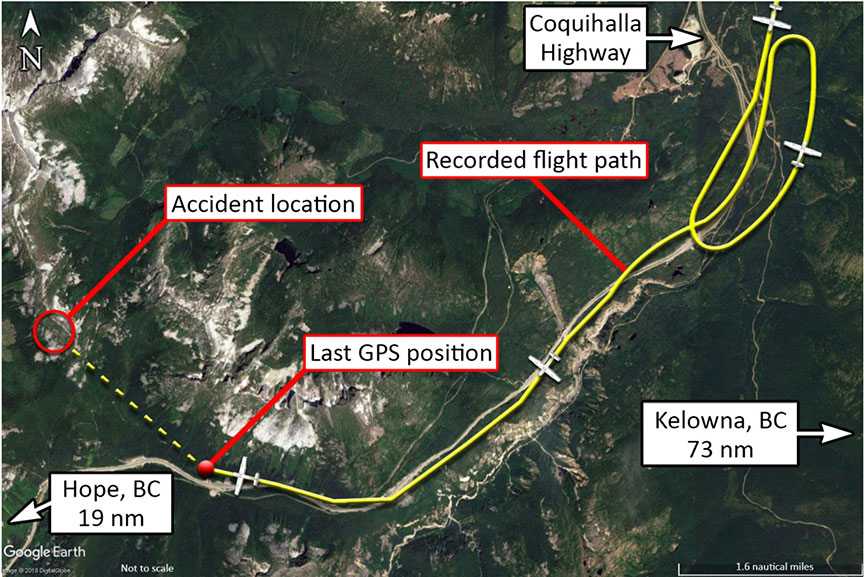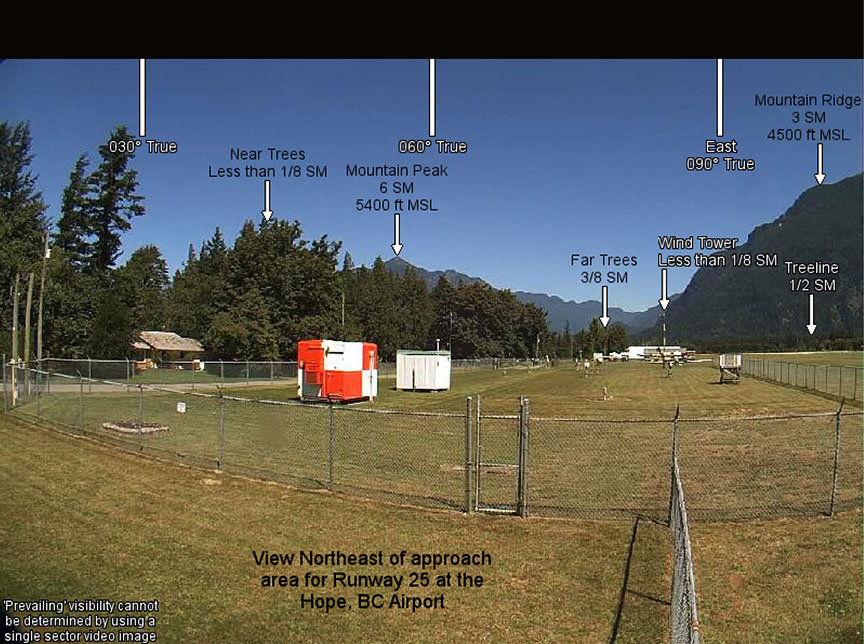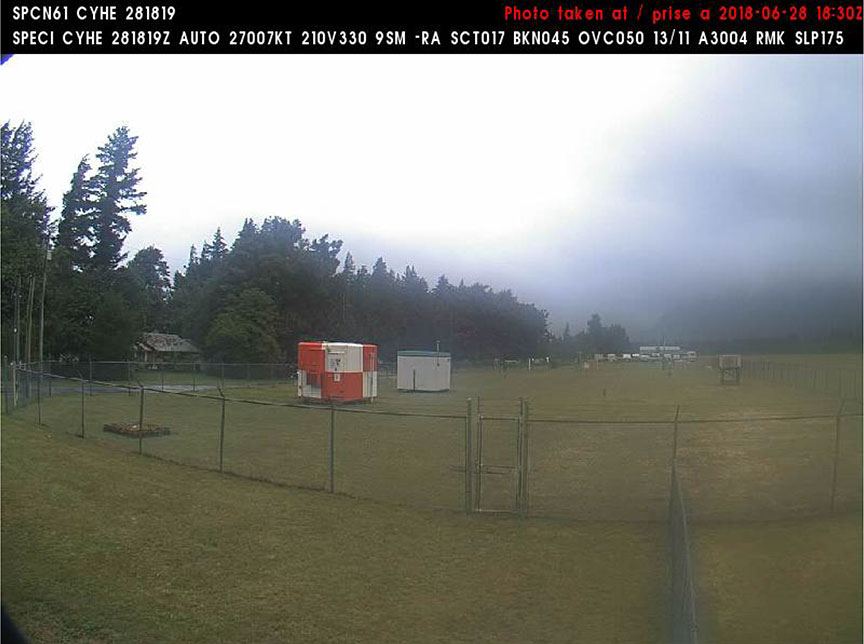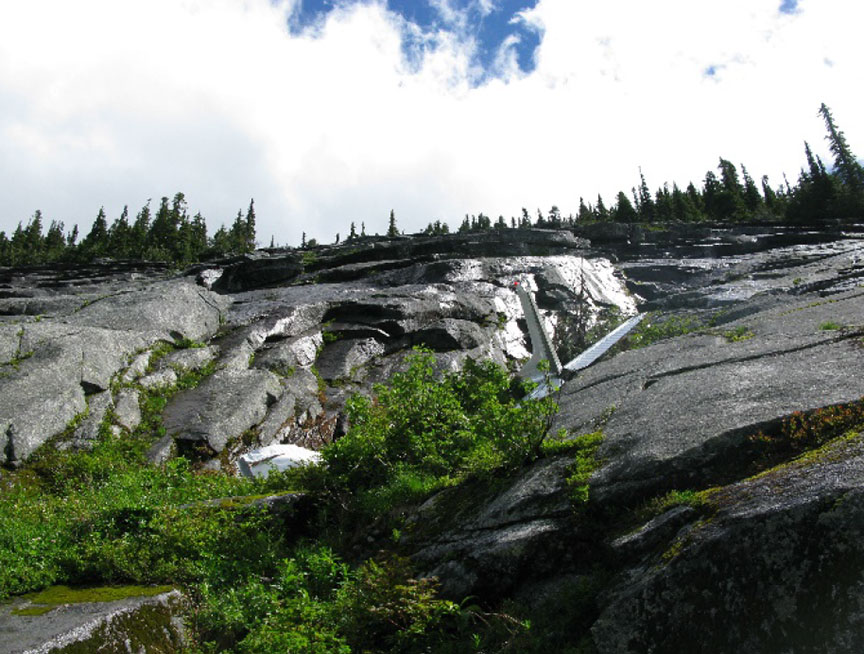Aviation News: Cessna 182P, C-GKKU Collision with Terrain
Posted: Tue Oct 13, 2020 3:03 am
Visual flight rules flight into deteriorating weather and collision with terrain
Cessna 182P, C-GKKU
Hope, British Columbia, 19 nm NE
28 June 2018 History of the flight At 0849Note de bas de page1 on 28 June 2018, the privately registered Cessna 182P (registration C-GKKU, serial number 18263475), departed on a visual flight rules (VFR) flight plan from Calgary/Springbank Airport (CYBW), Alberta, with 1 pilot and 1 passenger on board for a flight to Nanaimo Airport (CYCD), British Columbia. When the aircraft was northeast of Kelowna Airport (CYLW), British Columbia, the pilot requested flight following from air traffic control.Note de bas de page2 Radar and flight following services were terminated once the aircraft was outside of radar range, approximately 26 nautical miles (nm) northeast of Hope, British Columbia. The aircraft flew southwest above British Columbia Highway 5 until it was 5 nm north of the Coquihalla Summit Recreation Area. The aircraft reversed course for a short period of time before turning again to resume the original direction of travel above the highway. The aircraft’s altitude varied between 300 and 500 feet above ground level (AGL) during this time, and its speed was below the normal cruising speed. The last reliable global positioning system (GPS) position, at 1133, placed the aircraft in a climb at 4700 feet above sea level (740 feet above ground level) on a heading of 285° true. The aircraft flew northwest, away from the highway, and collided with a granite mountain slope (Figure 1). Figure 1. Depiction of the aircraft’s flight path, based on GPS data (Source: Google Earth, with TSB annotations) The Joint Rescue Coordination Centre in Victoria, British Columbia, received an emergency locator transmitter signal from the aircraft and initiated a search at approximately 1145. The initial search area was approximately 55 nm; however, low clouds and rain in the area hampered the search effort. At approximately 1330 on 29 June 2018, the crash site was found 19 nm northeast of Hope, near Zupjok Peak. Both of the aircraft’s occupants had been fatally injured. The aircraft had been destroyed by ground impact and a subsequent fire. Meteorological information The pilot obtained a weather briefing for the intended route via telephone from the Edmonton Flight Information Centre at 0548 and again at 0818 before filing the VFR flight plan. The briefing provided the following information for the intended route:
Figure 1. Depiction of the aircraft’s flight path, based on GPS data (Source: Google Earth, with TSB annotations) The Joint Rescue Coordination Centre in Victoria, British Columbia, received an emergency locator transmitter signal from the aircraft and initiated a search at approximately 1145. The initial search area was approximately 55 nm; however, low clouds and rain in the area hampered the search effort. At approximately 1330 on 29 June 2018, the crash site was found 19 nm northeast of Hope, near Zupjok Peak. Both of the aircraft’s occupants had been fatally injured. The aircraft had been destroyed by ground impact and a subsequent fire. Meteorological information The pilot obtained a weather briefing for the intended route via telephone from the Edmonton Flight Information Centre at 0548 and again at 0818 before filing the VFR flight plan. The briefing provided the following information for the intended route:  Figure 2. Northeast view taken at CYHE on a clear day (Source: NAV CANADA)
Figure 2. Northeast view taken at CYHE on a clear day (Source: NAV CANADA)  Figure 3. Northeast view taken at CYHE at 1130 on the day of the occurrence (Source: NAV CANADA) The automated weather observation system information from CYHE for 1119, approximately 16 minutes before the occurrence, indicated the following:
Figure 3. Northeast view taken at CYHE at 1130 on the day of the occurrence (Source: NAV CANADA) The automated weather observation system information from CYHE for 1119, approximately 16 minutes before the occurrence, indicated the following:  Figure 4. Accident site Visual flight rules flight over mountainous terrain in deteriorating weather conditions The hazards associated with continuing VFR flight into instrument meteorological conditions are well documented. According to data collected by the TSB between 2000 and 2014, accidents involving flights that depart under visual meteorological conditions and continue to a point where pilots lose visual reference with the ground have a high fatality rate. Over the 15-year period, these types of accidents resulted in 74 fatalities. In addition, factors such as flight experience, instrument training, and aircraft equipment must be considered during pre-flight planning to mitigate against in-flight hazards, such as encountering deteriorating weather conditions, particularly in mountainous terrain. Furthermore, lapses in critical piloting skills, such as decision making, maintaining situation awareness, and interpreting changing weather conditions, may exacerbate flight in such challenging conditions, increasing the likelihood of controlled flight into terrain (CFIT). The Flight Safety Foundation defines CFIT as “when an airworthy aircraft under the control of the flight crew is flown unintentionally into terrain, obstacles, or water, usually with no prior awareness by the crew.”Note de bas de page8 This type of accident often occurs in low visibility, at night, or in poor weather. These conditions reduce the pilot’s awareness of the surrounding area and make it difficult to visually determine the aircraft’s proximity to terrain. The risk of accident is even greater for aircraft that fly in mountainous terrain. Safety message Flying in deteriorating weather conditions is challenging; the associated risks need to be managed properly before and during flight, especially when flying over mountainous terrain. This concludes the TSB’s limited-scope investigation into this occurrence. The Board authorized the release of this investigation report on 28 December 2018. It was officially released on 16 January 2019. https://www.tsb.gc.ca/eng/rapports-reports/aviation/2018/a18p0090/a18p0090.htmlCheck out our Aviation and Pilots Forum www.Scudrunners.com
Figure 4. Accident site Visual flight rules flight over mountainous terrain in deteriorating weather conditions The hazards associated with continuing VFR flight into instrument meteorological conditions are well documented. According to data collected by the TSB between 2000 and 2014, accidents involving flights that depart under visual meteorological conditions and continue to a point where pilots lose visual reference with the ground have a high fatality rate. Over the 15-year period, these types of accidents resulted in 74 fatalities. In addition, factors such as flight experience, instrument training, and aircraft equipment must be considered during pre-flight planning to mitigate against in-flight hazards, such as encountering deteriorating weather conditions, particularly in mountainous terrain. Furthermore, lapses in critical piloting skills, such as decision making, maintaining situation awareness, and interpreting changing weather conditions, may exacerbate flight in such challenging conditions, increasing the likelihood of controlled flight into terrain (CFIT). The Flight Safety Foundation defines CFIT as “when an airworthy aircraft under the control of the flight crew is flown unintentionally into terrain, obstacles, or water, usually with no prior awareness by the crew.”Note de bas de page8 This type of accident often occurs in low visibility, at night, or in poor weather. These conditions reduce the pilot’s awareness of the surrounding area and make it difficult to visually determine the aircraft’s proximity to terrain. The risk of accident is even greater for aircraft that fly in mountainous terrain. Safety message Flying in deteriorating weather conditions is challenging; the associated risks need to be managed properly before and during flight, especially when flying over mountainous terrain. This concludes the TSB’s limited-scope investigation into this occurrence. The Board authorized the release of this investigation report on 28 December 2018. It was officially released on 16 January 2019. https://www.tsb.gc.ca/eng/rapports-reports/aviation/2018/a18p0090/a18p0090.htmlCheck out our Aviation and Pilots Forum www.Scudrunners.com
Cessna 182P, C-GKKU
Hope, British Columbia, 19 nm NE
28 June 2018 History of the flight At 0849Note de bas de page1 on 28 June 2018, the privately registered Cessna 182P (registration C-GKKU, serial number 18263475), departed on a visual flight rules (VFR) flight plan from Calgary/Springbank Airport (CYBW), Alberta, with 1 pilot and 1 passenger on board for a flight to Nanaimo Airport (CYCD), British Columbia. When the aircraft was northeast of Kelowna Airport (CYLW), British Columbia, the pilot requested flight following from air traffic control.Note de bas de page2 Radar and flight following services were terminated once the aircraft was outside of radar range, approximately 26 nautical miles (nm) northeast of Hope, British Columbia. The aircraft flew southwest above British Columbia Highway 5 until it was 5 nm north of the Coquihalla Summit Recreation Area. The aircraft reversed course for a short period of time before turning again to resume the original direction of travel above the highway. The aircraft’s altitude varied between 300 and 500 feet above ground level (AGL) during this time, and its speed was below the normal cruising speed. The last reliable global positioning system (GPS) position, at 1133, placed the aircraft in a climb at 4700 feet above sea level (740 feet above ground level) on a heading of 285° true. The aircraft flew northwest, away from the highway, and collided with a granite mountain slope (Figure 1).
 Figure 1. Depiction of the aircraft’s flight path, based on GPS data (Source: Google Earth, with TSB annotations) The Joint Rescue Coordination Centre in Victoria, British Columbia, received an emergency locator transmitter signal from the aircraft and initiated a search at approximately 1145. The initial search area was approximately 55 nm; however, low clouds and rain in the area hampered the search effort. At approximately 1330 on 29 June 2018, the crash site was found 19 nm northeast of Hope, near Zupjok Peak. Both of the aircraft’s occupants had been fatally injured. The aircraft had been destroyed by ground impact and a subsequent fire. Meteorological information The pilot obtained a weather briefing for the intended route via telephone from the Edmonton Flight Information Centre at 0548 and again at 0818 before filing the VFR flight plan. The briefing provided the following information for the intended route:
Figure 1. Depiction of the aircraft’s flight path, based on GPS data (Source: Google Earth, with TSB annotations) The Joint Rescue Coordination Centre in Victoria, British Columbia, received an emergency locator transmitter signal from the aircraft and initiated a search at approximately 1145. The initial search area was approximately 55 nm; however, low clouds and rain in the area hampered the search effort. At approximately 1330 on 29 June 2018, the crash site was found 19 nm northeast of Hope, near Zupjok Peak. Both of the aircraft’s occupants had been fatally injured. The aircraft had been destroyed by ground impact and a subsequent fire. Meteorological information The pilot obtained a weather briefing for the intended route via telephone from the Edmonton Flight Information Centre at 0548 and again at 0818 before filing the VFR flight plan. The briefing provided the following information for the intended route: - local ceilings at 1500 feet AGL
- cloud bases at 8000 feet with tops at 20 000 feet AGL (between Calgary and Hope)
- isolated towering cumulus cloud
- visibility: 6 statute miles
- scattered showers
- ceilings at 6000 to 7000 feet AGL, with increasing cloud west of Hope
 Figure 2. Northeast view taken at CYHE on a clear day (Source: NAV CANADA)
Figure 2. Northeast view taken at CYHE on a clear day (Source: NAV CANADA)  Figure 3. Northeast view taken at CYHE at 1130 on the day of the occurrence (Source: NAV CANADA) The automated weather observation system information from CYHE for 1119, approximately 16 minutes before the occurrence, indicated the following:
Figure 3. Northeast view taken at CYHE at 1130 on the day of the occurrence (Source: NAV CANADA) The automated weather observation system information from CYHE for 1119, approximately 16 minutes before the occurrence, indicated the following: - temperature: 13 °C
- dew point: 11 °C
- scattered cloud at 1700 feet, broken cloud at 4500 feet, overcast at 5000 feet AGL
- visibility: 9 statute miles in light rain
- wind: 7 knots variable from 210° to 330° true (T)
- barometric pressure: 30.04 inHg
 Figure 4. Accident site Visual flight rules flight over mountainous terrain in deteriorating weather conditions The hazards associated with continuing VFR flight into instrument meteorological conditions are well documented. According to data collected by the TSB between 2000 and 2014, accidents involving flights that depart under visual meteorological conditions and continue to a point where pilots lose visual reference with the ground have a high fatality rate. Over the 15-year period, these types of accidents resulted in 74 fatalities. In addition, factors such as flight experience, instrument training, and aircraft equipment must be considered during pre-flight planning to mitigate against in-flight hazards, such as encountering deteriorating weather conditions, particularly in mountainous terrain. Furthermore, lapses in critical piloting skills, such as decision making, maintaining situation awareness, and interpreting changing weather conditions, may exacerbate flight in such challenging conditions, increasing the likelihood of controlled flight into terrain (CFIT). The Flight Safety Foundation defines CFIT as “when an airworthy aircraft under the control of the flight crew is flown unintentionally into terrain, obstacles, or water, usually with no prior awareness by the crew.”Note de bas de page8 This type of accident often occurs in low visibility, at night, or in poor weather. These conditions reduce the pilot’s awareness of the surrounding area and make it difficult to visually determine the aircraft’s proximity to terrain. The risk of accident is even greater for aircraft that fly in mountainous terrain. Safety message Flying in deteriorating weather conditions is challenging; the associated risks need to be managed properly before and during flight, especially when flying over mountainous terrain. This concludes the TSB’s limited-scope investigation into this occurrence. The Board authorized the release of this investigation report on 28 December 2018. It was officially released on 16 January 2019. https://www.tsb.gc.ca/eng/rapports-reports/aviation/2018/a18p0090/a18p0090.htmlCheck out our Aviation and Pilots Forum www.Scudrunners.com
Figure 4. Accident site Visual flight rules flight over mountainous terrain in deteriorating weather conditions The hazards associated with continuing VFR flight into instrument meteorological conditions are well documented. According to data collected by the TSB between 2000 and 2014, accidents involving flights that depart under visual meteorological conditions and continue to a point where pilots lose visual reference with the ground have a high fatality rate. Over the 15-year period, these types of accidents resulted in 74 fatalities. In addition, factors such as flight experience, instrument training, and aircraft equipment must be considered during pre-flight planning to mitigate against in-flight hazards, such as encountering deteriorating weather conditions, particularly in mountainous terrain. Furthermore, lapses in critical piloting skills, such as decision making, maintaining situation awareness, and interpreting changing weather conditions, may exacerbate flight in such challenging conditions, increasing the likelihood of controlled flight into terrain (CFIT). The Flight Safety Foundation defines CFIT as “when an airworthy aircraft under the control of the flight crew is flown unintentionally into terrain, obstacles, or water, usually with no prior awareness by the crew.”Note de bas de page8 This type of accident often occurs in low visibility, at night, or in poor weather. These conditions reduce the pilot’s awareness of the surrounding area and make it difficult to visually determine the aircraft’s proximity to terrain. The risk of accident is even greater for aircraft that fly in mountainous terrain. Safety message Flying in deteriorating weather conditions is challenging; the associated risks need to be managed properly before and during flight, especially when flying over mountainous terrain. This concludes the TSB’s limited-scope investigation into this occurrence. The Board authorized the release of this investigation report on 28 December 2018. It was officially released on 16 January 2019. https://www.tsb.gc.ca/eng/rapports-reports/aviation/2018/a18p0090/a18p0090.htmlCheck out our Aviation and Pilots Forum www.Scudrunners.com